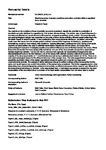Morphodynamics, boundary conditions and pattern evolution within a vegetated linear dunefield
| dc.contributor.author | Telfer, Matt | |
| dc.contributor.author | Hesse, PP | |
| dc.contributor.author | Perez-Fernandez, M | |
| dc.contributor.author | Bailey, RM | |
| dc.contributor.author | Bajkan, S | |
| dc.contributor.author | Lancaster, N | |
| dc.date.accessioned | 2017-05-25T14:20:25Z | |
| dc.date.issued | 2017-08-01 | |
| dc.identifier.issn | 0169-555X | |
| dc.identifier.issn | 1872-695X | |
| dc.identifier.other | C | |
| dc.identifier.uri | http://hdl.handle.net/10026.1/9351 | |
| dc.description | publisher: Elsevier articletitle: Morphodynamics, boundary conditions and pattern evolution within a vegetated linear dunefield journaltitle: Geomorphology articlelink: http://dx.doi.org/10.1016/j.geomorph.2017.03.024 content_type: article copyright: © 2017 Elsevier B.V. All rights reserved. | |
| dc.description.abstract |
The controls on the evolution of linear dunefields are poorly understood, despite the potential for reactivation of dunefields, which are currently stabilized by vegetation, under the influence of 21st century climate change. The relative roles of local influences (i.e. boundary conditions) and morphodynamic influences (i.e. emergent properties) remain unclear. Chronostratigraphic and sedimentological analyses were conducted on two pairs of linear dunes exhibiting different spatial patterning in the Strzelecki Desert of central Australia. It was hypothesized that morphodynamic influences, via pattern-coarsening, would mean that dunes from the simpler pattern, defined in terms of the frequency of defects (i.e. junctions and terminations), would be more mature, older landforms. Optically Stimulated Luminescence (OSL) dating of full-depth, regularly-sampled profiles was used to establish accumulation histories for the four dunes, and supported by sedimentological analysis to investigate possible compositional differences and similarities between the dunes. Whilst three of the dunes (the two more simply-patterned dunes, and one of the more complex dunes) have accumulation histories beginning between ~ 100 ka and 150 ka, and document sporadic net accumulation throughout the last interglacial/glacial cycle to the late Holocene, one of the dunes (with relatively complex patterning) reveals that the majority of the dune accumulation (> 7 m) at that site occurred during a relatively short window at ~ 50 ka. There is no clear sedimentological reason for the different behaviour of the younger dune. The data suggest that small-scale and essentially stochastic nature of the aeolian depositional/erosional system can overprint any large-scale morphodynamic controls. The concept of dating landscape change by pattern analysis is thus not supported by this study, and would require very careful interpretation of the scales being considered. This further suggests caution when interpreting dune chronostratigraphies palaeoenvironmentally, as different dunes are able to respond very differently to the same external stimulus (e.g. climate). In the case studied here, a mechanism is proposed to account for the rapid accumulation of the anomalous dune by avulsion of the local aeolian accumulation from one dune ridge to another. | |
| dc.format.extent | 85-100 | |
| dc.language | en | |
| dc.language.iso | en | |
| dc.publisher | Elsevier BV | |
| dc.subject | 13 Climate Action | |
| dc.title | Morphodynamics, boundary conditions and pattern evolution within a vegetated linear dunefield | |
| dc.type | journal-article | |
| dc.type | Journal Article | |
| plymouth.author-url | https://www.webofscience.com/api/gateway?GWVersion=2&SrcApp=PARTNER_APP&SrcAuth=LinksAMR&KeyUT=WOS:000405056100007&DestLinkType=FullRecord&DestApp=ALL_WOS&UsrCustomerID=11bb513d99f797142bcfeffcc58ea008 | |
| plymouth.volume | 290 | |
| plymouth.publication-status | Accepted | |
| plymouth.journal | Geomorphology | |
| dc.identifier.doi | 10.1016/j.geomorph.2017.03.024 | |
| plymouth.organisational-group | /Plymouth | |
| plymouth.organisational-group | /Plymouth/Faculty of Science and Engineering | |
| plymouth.organisational-group | /Plymouth/Faculty of Science and Engineering/School of Geography, Earth and Environmental Sciences | |
| plymouth.organisational-group | /Plymouth/REF 2021 Researchers by UoA | |
| plymouth.organisational-group | /Plymouth/REF 2021 Researchers by UoA/UoA14 Geography and Environmental Studies | |
| plymouth.organisational-group | /Plymouth/Users by role | |
| plymouth.organisational-group | /Plymouth/Users by role/Academics | |
| dcterms.dateAccepted | 2017-03-26 | |
| dc.rights.embargodate | 2018-4-5 | |
| dc.identifier.eissn | 1872-695X | |
| dc.rights.embargoperiod | 12 months | |
| rioxxterms.versionofrecord | 10.1016/j.geomorph.2017.03.024 | |
| rioxxterms.licenseref.uri | http://www.rioxx.net/licenses/under-embargo-all-rights-reserved | |
| rioxxterms.licenseref.startdate | 2017-08-01 | |
| rioxxterms.type | Journal Article/Review |


